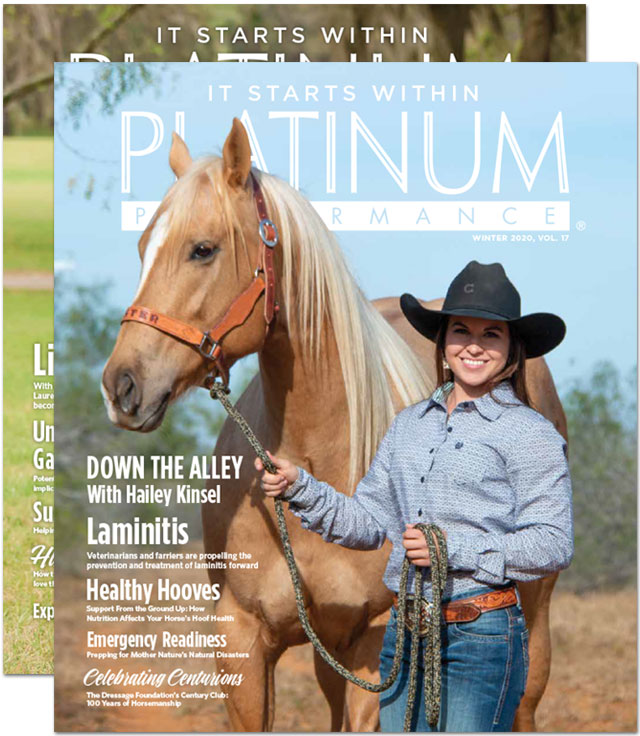Veterinarians With a Passion for Draft Horses Provide a Look Inside This Specialized World, From The Nuanced Aspects of Breeding, Training, Working and Showing, to The Specifics of Their Care, Farriery and Nutritional Needs
Like so many things in life, draft horses are a living, breathing juxtaposition: massive bodies and immense power contrasted by a signature gentleness and deep desire to please. With intimidating size and a never-say-quit work ethic, drafts have left a permanent mark on history and unquestionable contributions to both agriculture and industry.
Remarkable innovations and mechanizations came to be thanks to lessons learned in power and productivity from the draft. All of that aside, however, they’re simply captivating. I grew up with these giants as a child, perched beside my grandfather on the seat of a towering red wagon with lines in my small hands and a team of steady Percherons hitched to the tongue. This was the late 1980s into the ’90s. I mention the years because we certainly had the modern-day equipment available to make our California cattle ranch and hay operation run efficiently. Still, he preferred to roadside hay the old-fashioned way. Call it a combined passion for hard work, tradition and a good sweat. So, there we sat — my younger brother and I — lines in hand while my grandfather bucked hay bales into perfect alignment onto the flat bed of the wagon. He somehow trusted us to keep 4,000 pounds of horseflesh collected while he worked. Or perhaps, he trusted them. Those days were sacred, and those horses left a mark on our hearts, as did the countless other teams and single-cart drafts that came through our ranch over the years.
Some were strapping Clydesdales with long flowing feathers and glowing bay coats. Others were muscled copper Belgians or imposing jet-black Percherons. All were equal parts magic and intimidation; they looked almost medieval, as if they were headed into battle. Then, there were Blue and Joe, the dappled gray Percherons that for years pulled our red wagon around the ranch. They were thick and muscled, strong and kind; a matched pair in more ways than one. We rode them, learned to make sense of their labyrinth of harness and came to value them as friends.
As an adult, I know significantly more about the world of drafts, and how far it truly reaches beyond what I experienced as a kid. Like so many disciplines within the horse world, drafts play a leading role in vastly different realms, from pulling competitions, hitch driving, halter showing, riding and breeding to the still-invaluable job as work horses on the farm. Then, there are the people. The folks within this world are long on passion and certainly don’t shy away from hard work. Their lives revolve around their drafts and the varying ways they enjoy them. These horses are the centerpiece of a dynamic and tight-knit community, carrying a rich history and deep contributions, in the past and present.
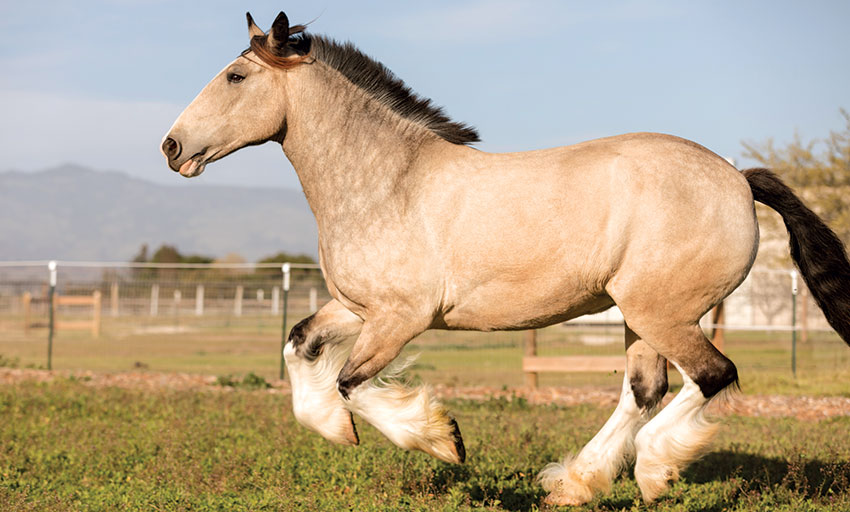
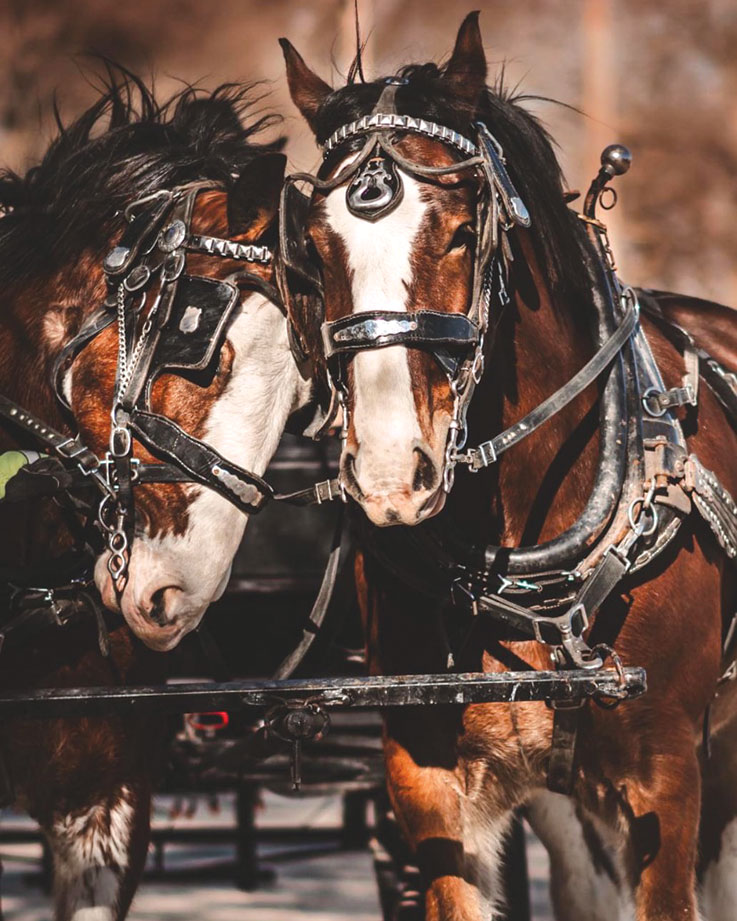
With roots tracing back to western Europe, drafts were imported to America in the 1820s. Known for their tell-tale height, heavy musculature and solid bones, drafts typically stand anywhere from 16 to 19-plus hands and can easily weigh 1,400 to 2,000 pounds or more.
A Hand In History
While today’s drafts are more at home in a show ring or on a parade route, that wasn’t always the case. Their origins trace back to western Europe before being imported to America in the 1820s and woven into the fabric of this nation as it progressed over centuries. Today, drafts provide the muscle in front of a wagon, under saddle, in competition and are still a vital tool on farms and ranches across the country.
Known long ago as “dray horses” (derived from the Old English word dragan meaning “to draw or haul”) modern-day drafts remain regarded for their tell-tale height, heavy musculature and solid bones. Dwarfing most lighter or more common breeds, drafts typically stand anywhere from 16 to 19-plus hands and can easily weigh 1,400 to 2,000 pounds or more.
By the late 19th century, America recognized five primary draft breeds with newly forming registries: Belgians (from Belgium); Clydesdales (from Scotland); Percherons (from France); Shires; and Suffolks (both from England). Percherons quickly took the lead as the most-prolific breed in North America, joining the other four as fixtures and vital resources among agriculturalists coast to coast.
While drafts have transitioned into more sport and leisure-based roles, Amish and Mennonite communities still rely heavily on their strength in front of a plow or wagon. There’s something about a team of these horses, lathered up and doing the work that seems engrained in their DNA. It’s an endearing sight and one reminiscent of the necessary elbow grease that helped build and feed this country.
Contributing Veterinarians
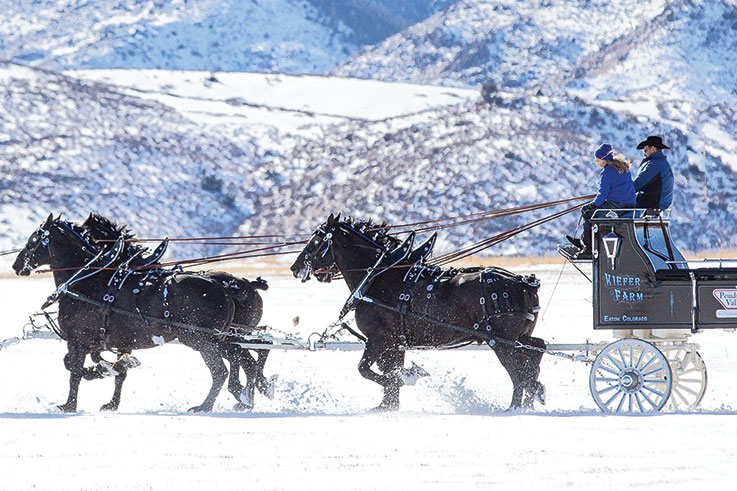
Dr. Stacie Wells-Kiefer, Eaton, Colorado
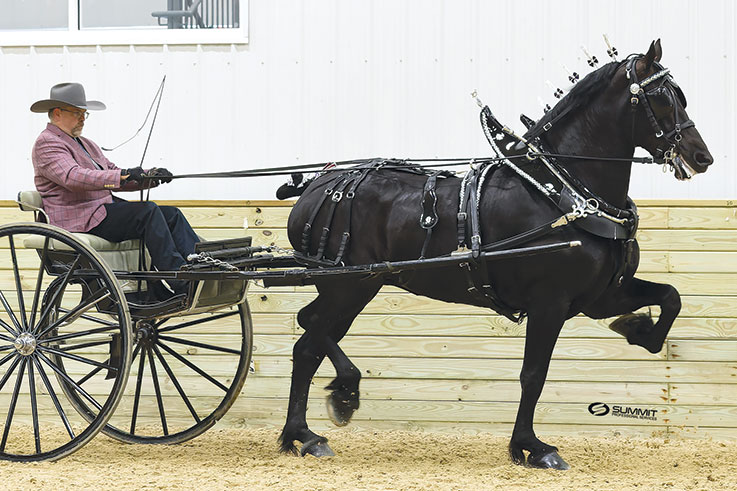
Dr. Chad Zubrod, Oakridge Equine Edmond, Oklahoma
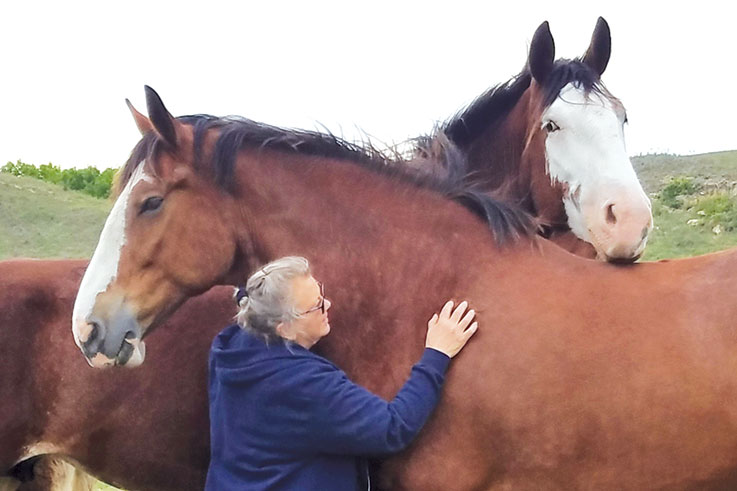
Dr. Kris Harris, Western Prairie Veterinary Services Hays, Kansas
Hitched to the Heart
There are few events that captivate a crowd more than draft horse hitch competitions around the country. The horses at major stock and specialty shows are groomed to perfection, adorned with polished leather harness and hitched to gleaming wagons with drivers and shotgun riders dressed in their finest. Manes are rolled with decorative ribbon, tails braided and affixed just so, feathers — the long hairs covering polished hooves — groomed and coats shining like polished glass; the amount of skill and precision it takes to navigate a team — let alone a four- or six-horse hitch — is remarkable. Not to mention, in a show there can be several other hitches of the same size in the arena doing the same thing at the same time. It’s like a well-choreographed dance, but the lithe dancers happen to be 2,000 pounds of raw muscle and collected energy.
These horses are surprisingly athletic given their size, and watching them in action is mesmerizing. The drivers are laser-focused with leather-gloved hands expertly managing multiple sets of lines at once — three in each hand for a six-horse hitch — with just the right amount give and pressure to control the massive weight on the other end. From horse to driver, it’s pure skill and teamwork.
Spend any amount of time in the draft world, and you’ll quickly learn that show hitches come in a variety of sizes. From a single horse at the lead of a carriage or wagon to six- or even eight-hitch teams (known also an “eight-up” or “eight-inhand” team). It seems that grooms and drivers know their horses at a cellular level. They anticipate how each horse will react in the barn aisle, at show prep and under pressure on the hitch. Specifics in temperament as well as size, weight and strength determine the designated position in the ranks for each hitch horse. “Wheelers,” or the pair hitched closest to the wagon, are typically the brute force of the team, responsible for sheer pulling power (carrying about 60 percent of the load). Next, the middle pair of a hitch are the “swing” horses. These slightly smaller, lighter and more-agile horses play a key role in turns and maneuvering. Finally, the lead team — the flashiest two of the pack — is made up of smaller yet highly athletic, engaged and alert horses. The horses are worked in each position, then moved to determine their best and final fit within the hitch. One general rule is competing hitches typically are made up of drafts of a uniform breed, color, markings, relative size, and they tend to be all mares or all geldings.
Hitch competitions can take on numerous appearances whether the class caters to smaller or larger numbers of horses. Drafts make ideal single-cart horses. When paired, they can appear in front of a wagon in numerous forms: as a standard side-by-side team; a tandem team with one horse in front of the other; a unicorn hitch with two wheelers and one lead horse out front; a four-abreast team positioned side by side; or a foursix- or eight -in-hand team with each set of two followed by another pair in front of them. The wagons towed behind this kind of horsepower get larger and heavier as the hitch size increases — so does the need for a shotgun rider in case the driver quickly needs extra hands to help control the horses on the ground.
Most wagons are outfitted with a foot brake in addition to the lines in the driver’s hands. Both play a vital role controlling the hitch.
As each hitch enters the show ring, it heads for the right side of the arena, making a counter-clockwise lap followed by a few more before turning and heading in the opposite direction. Though the pattern can take several forms, this is the standard route before each hitch lines up side-by-side in the middle of the arena. Next, each driver is asked to back up several feet, then move forward to their original position and stop. Judges evaluate each hitch from the moment it enters; they’re looking at the horses, harness, wagon and the control and precision the driver has over their team. Drivers of these massive rigs make it look easy controlling two to eight horses at one time, subtly coaxing them to move in unison, turn as a team, back up with grace as a unit and keep their wits about them in an environment with more than a few distractions. For the audience, it’s poetry in motion — both mesmerizing and anxiety-inducing to watch.

“There just aren’t that many people out there who can drive a six-horse hitch anymore. It’s a great community of people though. We help each other, and we all love these gentle giants.”
— Dr. Stacie Wells-Kiefer, She and her husband train and operate their own six-horse hitch of Percherons
Heavy Lifting Behind the Scenes
As is often the case with something that looks easy, the real work happens behind the scenes. The amount of individual attention, schooling, grooming, training and veterinary work required to maintain a hitch — or even a single working draft — and allow them to flourish is remarkable; it’s staggering even. Not surprisingly, there are several equine veterinarians who do it all: work throughout the day caring for their patients before heading home to begin again with their own drafts. These veterinarians spend their “me time” doing just what they want, often dressed in coveralls in freezing temperatures, in the hot sun or driving wind. They work against the conditions, training a six-in-hand team of heavy horses until well past sundown. Among them are: Dr. Kris Harris of Western Prairie Equine Service in Hays, Kansas; Dr. Chad Zubrod, an equine surgeon at Oakridge Equine in Edmond, Oklahoma; and Dr. Stacie Wells-Kiefer, an equine ambulatory veterinarian from Eaton, Colorado. I had the good fortune of learning from each, not only about drafts and how they keep these imposing steeds healthy but also about their individual passions within the draft world.
While Dr. Harris’ love of drafts stays on the professional level within her practice and with the Clydesdales, Belgians and Percherons she treats, Dr. Zubrod was raised around drafts since childhood. He left this niche corner of the horse industry to pursue a veterinary degree and residency. Then, once in practice, the married father of two realized how much he missed having the big horses in his life. He and his family now breed Percherons, train and operate their own hitch of mares and proudly watch as their teenage daughter takes the lines as an up and coming hitch driver herself. Dr. Wells-Kiefer, like Dr. Zubrod, is an equine veterinarian by day and a passionate draft hitch owner by evening. She and her husband train and operate their own sixhorse hitch of Percherons and travel to shows and exhibitions in Northern Colorado and throughout the region. “It’s a bit of a dying art,” she says. “There just aren’t that many people out there who can drive a six-horse hitch anymore. It’s a great community of people though. We help each other, and we all love these gentle giants.” The key word is “community.” It takes a village to not only care for drafts but to successfully travel and show with them. “My husband and I get up in the morning and clean seven to eight stalls plus the stalls at the veterinary clinic,” Dr. Wells-Kiefer says of her routine that’s centered on the needs of her drafts and patients. Post stall-cleaning, the couple put in a full day’s work before reconvening at their two-and-a-half-mile track, where they pony their drafts for 4 miles every other day, then harness and drive them on a sled or harrow on the off days. The program builds muscle and increases endurance. At home, the horses are typically driven in a light, nylon or other synthetic- fiber harness that’s easy to lift and clean. A show harness may be beautiful, but it is surprisingly heavy and requires extraordinary maintenance; working with that volume of leather makes it an unnecessary burden during training. Moreover, leather show harness costs from $10,000 to $15,000 per horse. In a six-horse hitch, that quickly adds up to real money.
In Dr. Zubrod’s case, his family farm has some 40 drafts occupying the land as part of his breeding program or as working and competing horses in his hitch of six-in-hand ebony Percherons. “There are 12 to 15 horses that are in the barn getting driven at any given time,” he says. “Then, there’s probably four to six 2-year-olds and four to six yearlings, not to mention the weanlings. We’ve also had 11 foals on the ground this season.” The horses accumulate quickly at Zubrod Percherons, the Zubrod family’s farm in Guthrie, Oklahoma, where many drafts are sold to other hitch enthusiasts while others are kept, trained and eventually integrated into the family’s hitch.
At-home training is an arduous task, with long hours and late nights spent schooling the horses to operate in precision alignment and with the utmost safety. With so many moving parts and heavy horseflesh, things can go sideways in an instant if drivers and grooms aren’t hyperfocused. Luckily, the draft horse industry is made up of people who not only care deeply for the horses but are also consummate professionals. Plain and simple: It’s safety first. Aside from training, prepping for a show entails its own to-do list before the horses are loaded and the trailer heads down the road. It begins “at least two weeks before we go,” explains Dr. Wells-Kiefer. “They’re all washed and clipped, their feet are sanded and shod, the wagons, carts, feed and supplies are loaded, as well as all of the harness.” The horses are loaded onto a semi-truck with a capacity for six horses plus the wagon and gear, although another truck and trailer will accompany the semi with additional equipment and room for a few horses if needed. “The morning that we leave, each horse is brushed, and we put shipping boots on them to protect their legs and feet.” Once the team arrives at the show, Dr. Wells-Kiefer, her husband and a crew of up to six additional hands tackles bedding stalls, walking the horses numerous times per day and sticking to the drafts’ feeding regimen.
Depending on the show and specific class, spectators may see corporate-sponsored hitches (such as from Young Living Essential Oils or Express Ranches) or family-owned and operated hitches like those of Drs. Wells-Kiefer and Zubrod. “We don’t compete against the corporate hitches, so our goal is to get into the arena, have a good safe drive and have fun,” says Dr. Wells-Kiefer of her team’s mission. Her hitch is made up of strapping geldings — the most frequent choice for competition drafts. The draft world has become more balanced, however, with numerous hitches now comprised of mares. “We’ve discovered that the mares are just as athletic and capable as the geldings, so you’re seeing a lot more hitches lean that way recently,” she explains.
While shows can be a strain for families, the drafts were modeled for hard work. They love it. It’s in their blood, and heavy lifting is where they find their stride. “Throughout their history, these horses have been harnessed at 5 o’clock in the morning, and they’re out in the fields working. They would get a short break in the middle of the day, then they’re right back out there until dark. They love to work. They were developed to work,” confirms Dr. Wells-Kiefer of a draft’s innate desire to go the distance.
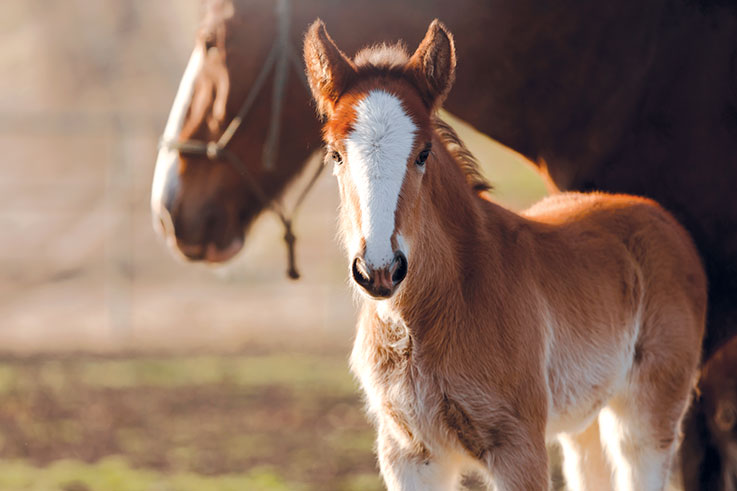
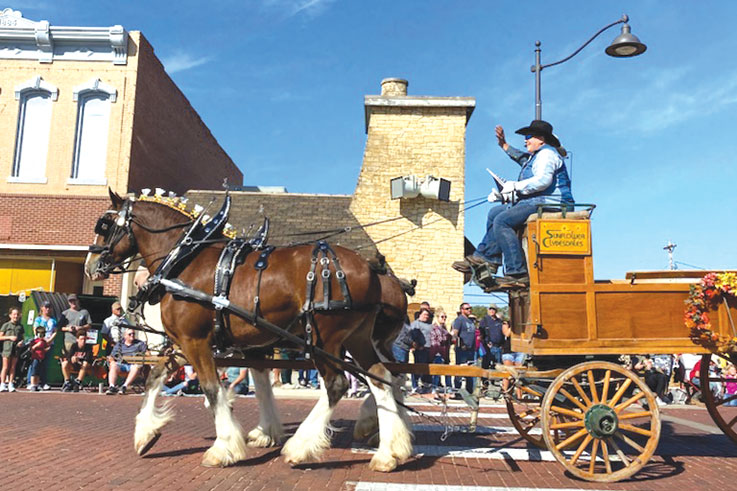
Draft breeds are a lesson in opposites: soft and strong; gentle and powerful; sturdy yet vulnerable.
Pulling for You
While brushed, braided and polished draft hitches are stunning to watch, there’s another side of the draft world. Horse Pulling capitalizes on sheer strength; hitching a single horse or team to various types of weighted sleds with the entry that pulls the most weight over a set distance earning the crown. There are varying weight classes and strict rules to protect the horses, but these drafts love to pull, compete and put their impressive muscles to work. The horses are conditioned throughout the year and arrive at competition ready to give it their all.
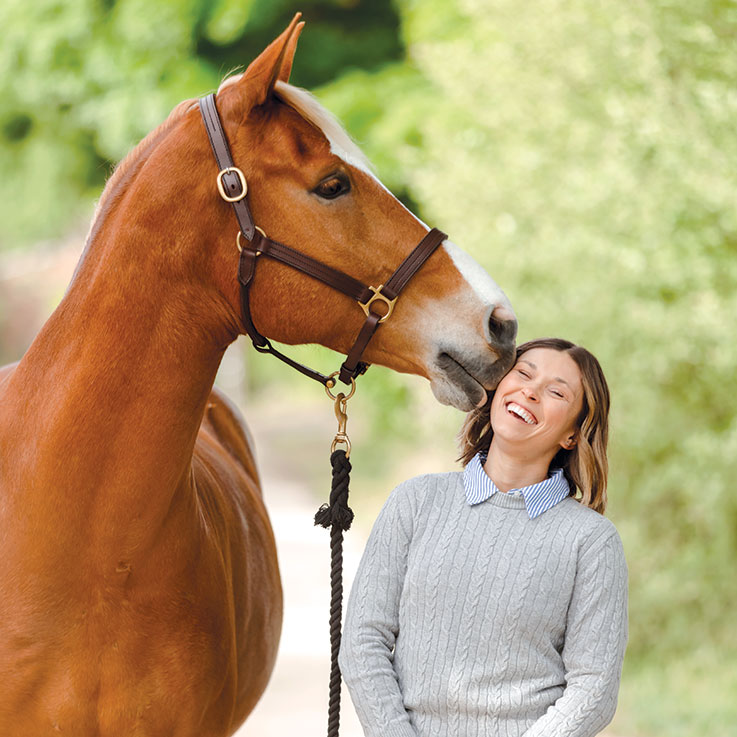
Breed: Belgian Draft x Arabian
Discipline: All-Around
Health Concerns: Skin & Year-Round Allergies, PSSM
Platinum Formula: Platinum Skin & Allergy
Meet Barney, the Belgian Draft Cross
“Barney is a one-of-a-kind horse who was dealt a tough hand, physically. He reminds me that listening to our equine partners is the key to our success with them. He has allergies to both dietary and environmental triggers and would suffer from severe reactions. The Platinum Skin and Allergy formula has been a lifesaver for my big guy! Since starting him on this supplement, his skin has been normal and healthy despite exposure to seasonal allergens. It is the only thing I’ve found that makes a difference in his comfort, and I love that he is not on daily medication any longer.”
— Emily R., Platinum Performance® Client since 2019
Drafts may be a small portion of the horse world, but these giants will steal your heart in an instant if you let them, and rightly so. They’re magnificent.
Rising Popularity of Draft Crosses
With a steady temperament, strength and durability, it’s not surprising that draft crosses are increasingly popular, from pleasure riding to dressage, working ranch horses, even pickup and bucking horses in rodeos. Like their purebred draft association counterparts — that require DNA-typing of mares and stallions to register — the International Draft and Sporthorse Registry (IDSHR) has seen the numbers of registered draft crossbreeds rise significantly. To register with the IDSHR, a horse’s pedigree must contain at least 25% of a specific breed. Clydesdale, Belgian and Percheron mares are most commonly crossed with Thoroughbred or Quarter Horse stallions, creating a meld of ideal traits. Crosses make exceptional mounts that the registry predicts will continue to be popular with sport and pleasure riders.
In addition, breeders are frequently crossing drafts — Belgians in particular — with the American Mammoth Jackstock, descended from large donkeys, to create hearty working draft mules. These longeared giants maintain the desirable traits mules are known for — strength, surefootedness, durability and a tremendous work capacity — then add a healthy dose of draft musculature and size. It’s a combination favored for working teams and certainly one that is rising in popularity.
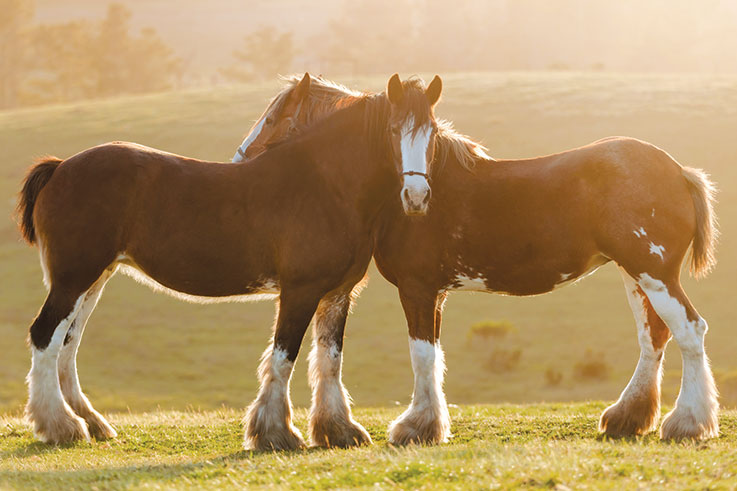
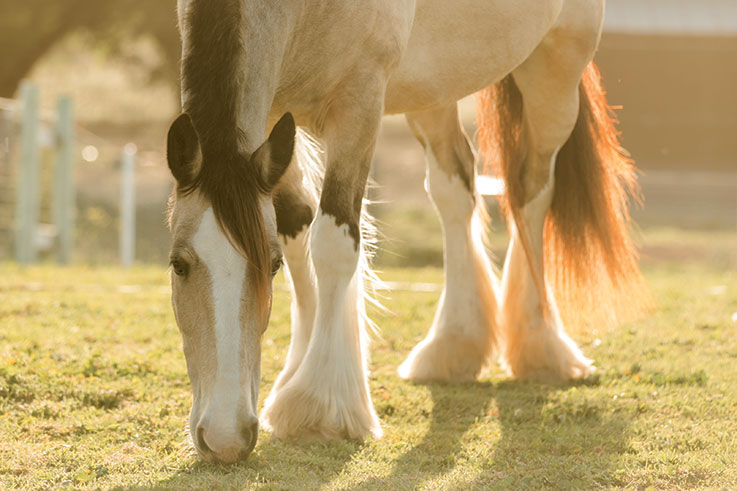
Most feed labels are designed for an 1,100-pound horse, not for these big-boned giants. Some larger draft horses (weighing 2,000 pounds or more) may require doubling that feeding rate in order to achieve the nutrient intake needed to meet nutritional requirements.
PHOTOS BY ELIZABETH HAY PHOTOGRAPHY
“One of the most difficult things we encounter is finding farriers to work on our draft patients. Picking up and holding their feet is hard work.”
— Dr. Kris Harris, Western Prairie Equine Service
A Veterinary View of Drafts
With great power and size comes certain nuances that make the care of drafts similar to lighter breeds but with marked differences. Drafts, for instance, have notoriously difficult feet. This is due to a combination of their weight — large, heavy horses balanced on relatively small feet — and need for somewhat specialized farriery. “In addition, the draft coffin bone has a little bit of a different shape to it,” says Dr. Zubrod. “It’s broader and more flat than that of a Quarter Horse or Thoroughbred.” Dr. Harris agrees, adding: “One of the most difficult things we encounter is finding farriers to work on our draft patients. Picking up and holding their feet is hard work.” Drafts also need to be carefully watched after orthopedic surgery in particular. “We can quickly run into problems after we operate on a leg and the draft is recumbent for a long period of time,” says Dr. Zubrod. “No matter how well you support them, the sheer amount of weight on the contralateral (opposite) limb can make it a race against time in trying to avoid myositis or laminitis post-operatively.” These large horses also face respiratory challenges, an increased incidence of neuromuscular disorders, such as shivers and a surprising sensitivity to anesthesia. “We give about half of the dose per pound for anesthetics and most sedations than we would on a lighter horse,” explains Dr. Harris. Adds Dr. Wells-Kiefer: “We see heart issues like atrial fibrillation in the larger drafts. Also, we’re starting to see laryngeal paralysis on occasion as well.” The reason is genetics. “Historically, draft horses that used to work the fields were shorter and stockier. We’ve now bred them to be bigger, longer-necked, more-athletic, more-animated horses. With that evolution can come some of these conditions,” she points out.
Proper nutrition is paramount in drafts. “A very balanced diet is critical to these draft horses,” Dr. Wells-Kiefer adds. “We look carefully at our hay and sugar content, also monitoring when we let them graze and for how long. We also make sure we’re using a gut supplement.” This focus on nutrition is shared by Dr. Harris. “I’ve seen a lot of undernourished drafts. They need the right calorie sources, fiber and a good hay source just as lighter horses do,” she says.” We focus on recommending those components, and we’ve added Platinum Performance® Equine in as well to help meet their needs in terms of vitamins, minerals and those good fats.” Drafts also can have a slightly-elevated predisposition to colic. “If they’re sick, they can go downhill rapidly. We watch them closely,” assures Dr. Wells-Kiefer. As in lighter horses, maintaining annual wellness exams, vaccinations, deworming protocols, fecal egg count tests and proper dentition is key. “We make sure these big horses are getting the same quality preventive care as our lighter patients are,” ensures Dr. Harris.
Feeding the Draft Horse: Nutritional Nuances
Supporting This Large Breed’s Specific Needs
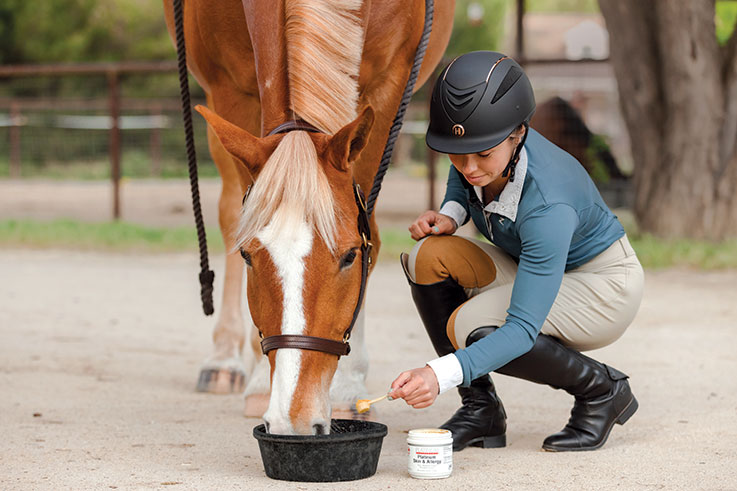
In feathered drafts, skin issues can be a challenge. Advanced nutrition can offer support for horses known to experience seasonal skin and allergy challenges.
Digging further into the unique feeding requirement of drafts, you will find that multiplication is often required. Most feed labels are designed for an 1,100-pound horse, not for these bigboned giants. Some larger draft horses (weighing 2,000 pounds or more) may require doubling that feeding rate in order to achieve the nutrient intake needed to meet nutritional requirements. It’s a good rule of thumb to get an estimated body weight on your draft, then do the math to properly determine their intake requirement of any nutritional product.
Drafts like other horses thrive on a diet of high-quality forage. Just how much is the question. Typically, horse owners should provide 1.5% of the draft’s body weight at minimum (for instance, an 1,800 pound Percheron would need to consume at least 27 pounds of hay per day). If the horse needs to boost its body condition score (BCS), hay intake can be increased for greater calories. Choosing the right oil to add healthy calories is an excellent tool as well. Look for cold-pressed flax oil, which will deliver a pure dose of omega-3 fatty acids. Avoid omega-6 fats and oils such as corn oil. Like you would with lighter horses, using a comprehensive wellness supplement can nicely fill nutritional gaps left behind by forage and help ensure your draft receives the necessary omega-3 fatty acids, antioxidants, vitamins and minerals that even the healthiest diets can fall short in.
Breed-Specific Nutrition Tips
In feathered drafts like Clydesdales, skin issues (pastern dermatitis or scratches) can be a challenge, and while good management and veterinary intervention cannot be replaced, advanced nutrition can offer support for horses known to experience seasonal skin and allergy challenges. Once water is removed, the skin is comprised of approximately 95% amino acids. Support skin integrity with the proper essential amino acids, trace minerals, such as zinc and copper, as well as antioxidants and omega-3 fatty acids.
Drafts such as Percherons and Belgians can suffer from a genetic muscle disease called polysaccharide storage myopathy (PSSM) type 1. Draft horses with this medical condition will often show symptoms of tying-up, or azoturia, after exercise. This is due to abnormal gylcogen (sugar) storage in the muscle and will require a low nonstructural carbohydrate (NSC) diet and consistent exercise. The diet should still be primarily forage; use caution with pasture access as grasses tend to be high in nonstructural carbohydrates. Ideally, hay should be tested for NSC content with a goal of under 12%. If additional calories are needed by the individual, they should be provided in the form of fat. A comprehensive wellness supplement can be a good choice for these cases, helping to complement forage and support the whole horse.
Easy Keepers
Not surprisingly, as with many other breeds, draft horses tend to be “easier keepers.” It can be a challenge when owners want to see their draft breed “filled out” in certain areas of their body, but there is a fine line between a healthy BCS and one that isn’t. Drafts that are overweight (too high of a BCS) are at greater risk of developing metabolic disorders, not to mention putting additional strain on the joints, tendons and ligaments of an already large animal. Utilize a BCS assessment to determine where the horse falls on the scale. The goal is a healthy BCS of 5-6. If your horse ranks at a higher score, then reduce calories from their diet without sacrificing nutrients. Removing all grains and concentrates, slowly decreasing forage intake to no less than 1.5% of their body weight and feeding a comprehensive wellness supplement to ensure the diet remains nutrient rich will help achieve the goal. Small hole nibble nets (1- to 1.5-inch openings) will help slow an overweight draft’s consumption. By slowing the rate at which they eat, they’re more closely mimicking Mother Nature’s grazing behavior, chewing for more hours of the day, which produces saliva, a buffering agent that positively impacts acid that is naturally produced in the stomach.
— By Abby Keegan, MS, PAS, Platinum Performance® Equine Nutritionist
“It takes a great bunch of people who show up to support us, from the team at the clinic to the family at home and our friends who are with us at shows. It's a small industry, and we’re all friends. We try to beat each other in the ring, but we’ll help each other in any way we can. It's a very close-knit bunch of people who want to see each other succeed.”
— Dr. Chad Zubrod, An equine surgeon at Oakridge Equine who also has a family farm of drafts, which includes a breeding program, working horses and up to six-in-hand competitive hitch teams
The Bigger They Are, The Harder We Fall
Ask anyone who has owned, ridden or driven a draft and they’ll tell you how intensely they capture your heart. With so much power, stature and a storied history as work horses, they’ve found their way into modern times and provided riders with joy and awe. Thomas Edison so famously said: “Opportunity is missed by most people because it’s dressed in overalls and looks like work.” The draft lives to work. They’re very much a lesson in opposites: soft and strong; gentle and powerful; sturdy yet vulnerable. These workhorses provided the power to expand agriculture across the world, and now, they contribute greatly to those who own, ride and drive them. “They’re so versatile,” says Dr. Wells-Kiefer. “You can go for a Sunday drive, show them in dressage or work them in the fields. They’re kind to be around and so are the people in the draft community. We help each other, first and foremost,” she says. It’s a sentiment shared by Dr. Zubrod: “It takes a great bunch of people who show up to support us, from the team at the clinic to the family at home and our friends who are with us at shows. It’s a small industry, and we’re all friends. We try to beat each other in the ring, but we’ll help each other in any way we can. It’s a very close-knit bunch of people who want to see each other succeed.”
His veterinary workday starts just after dawn and extends until the final drafts are buttoned up in their stalls at home long after sunset. Sixteen hours makes for a long day, but it’s also a fruitful and satisfying one. Horse people know exactly why these folks put in the extreme amount of effort that drafts require. Somewhere at the intersection of good horses and good people, we all find the “why” that explains our willingness — even our eagerness — to do it.
As Drs. Harris, Wells-Kiefer and Zubrod told their stories, I understood. My mind kept drifting back to hot afternoons driving my grandfather’s wagon, snacking on cold apples out of a cooler with hands calloused from leather lines. I remember my grandfather reminding us to really take in the view — golden mountains, green oaks and hay bales stretching as far as my brother and I could see — and all of it visible over the backs of two loyal, sturdy, harnessed drafts named Blue and Joe. I could smell their sweat in the air and see a whisp of gray horsehair float toward me every now and then. They painted unforgettable memories on the canvas of my childhood. Then again, drafts have done that for most people who have had the good fortune to love them. The people who keep the draft horse world alive and thriving do it for the joy. The hard work this lifestyle requires certainly pays off in spades, and the horses give back exponentially more than they receive.
Drafts may be a small portion of the horse world, but these giants will steal your heart in an instant if you let them, and rightly so. They’re magnificent.


